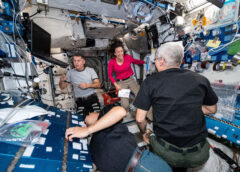
Credits: NASA
Students from three states will hear from astronauts from three different countries aboard the International Space Station next week. The Earth-to-space calls will air live on NASA Television, the NASA app, and the agency’s website.
On Monday, July 12, NASA astronauts Shane Kimbrough and Megan McArthur will answer prerecorded video questions from North Carolina students beginning at 10 a.m. EDT. The downlink is facilitated by the University of North Carolina – Chapel Hill’s Morehead Planetarium and Science Center. The event will be held virtually. Media interested in covering the event should contact Jonathan Frederick at 919-843-8329 or jfred@unc.edu.
On Wednesday, July 13, Kimbrough and Japan Aerospace Exploration Agency (JAXA) astronaut Akihiko Hoshide will answer prerecorded video questions from students in Wisconsin beginning at 10 a.m. EDT. The downlink is being coordinated by Discovery Outreach, an inter-institutional collaboration between the University of Wisconsin-Madison, the Morgridge Institute for Research, the Wisconsin Institute for Discovery, and the Wisconsin Alumni Research Foundation. The event will be held virtually. Media interested in covering the event should contact Jeanan Yasiri Moe at 608-960-9892 or jyasirimoe@warf.org.
On Wednesday, July 14, McArthur and ESA (European Space Agency) astronaut Thomas Pesquet will answer prerecorded video questions from New York State students beginning at 9 a.m. EDT. The downlink is facilitated by The Children’s Museum at Saratoga and the Clifton Park-Halfmoon Public Library. The event will be held virtually. Media interested in covering the event should contact Sarah Smith at 518-728-4280 or ssmith@cmssny.org.
Linking students directly to astronauts aboard the space station provides unique, authentic experiences designed to enhance student learning, performance, and interest in science, technology, engineering, and mathematics. Astronauts living in space on the orbiting laboratory communicate with NASA’s Mission Control Center in Houston 24 hours a day through the Space Network’s Tracking and Data Relay Satellites.
For more than 20 years, astronauts have continuously lived and worked on the space station, testing technologies, performing science, and developing the skills needed to explore farther from Earth. Through NASA’s Artemis program, the agency will return astronauts to the Moon, with eventual human exploration of Mars. Inspiring the next generation of explorers – the Artemis Generation – ensures America will continue to lead in space exploration and discovery.
Follow America’s Moon to Mars exploration at:
https://www.nasa.gov/topics/moon-to-mars
Follow NASA astronauts on social media at:
https://www.twitter.com/NASA_astronauts
See videos and lesson plans highlighting research on the International Space Station at:
https://www.nasa.gov/stemonstation


